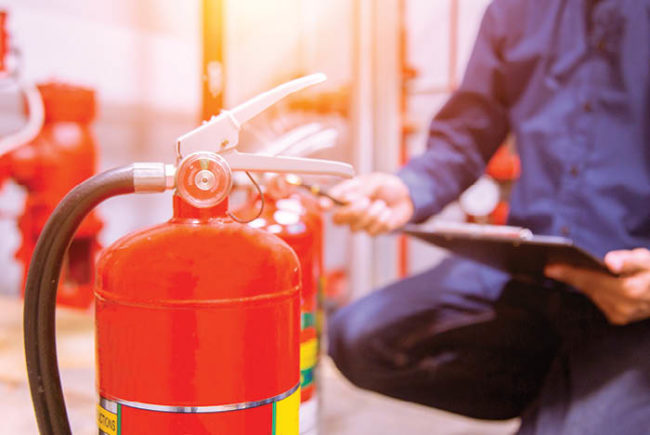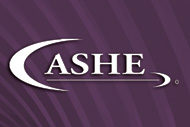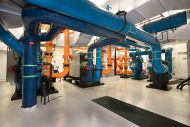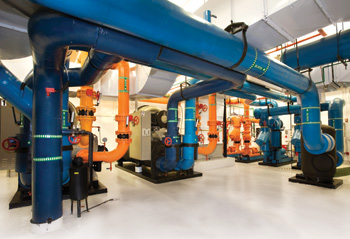 |
|
Distribution lines for a typical hospital central utility plant. Photo © iStock.com/Rgaydos |
Constant and sometimes unpredictable change is a pressing challenge for today's health facilities professionals.
New facilities are being acquired or constructed, new alliances are forming and health care organizations are expanding. Each facility within a health care system often has a unique infrastructure with challenges different from their sister medical centers or outpatient facilities.
This is especially true with cooling water systems, which may fall on a spectrum of aging equipment to newly constructed, state-of-the-art central utility plants.
Achieving efficiency
How can today's facilities professionals account for all of these variables and stay true to the organization's goals and objectives of optimum efficiency and equipment reliability and safety, while reducing operating expenses?
First, they should discuss their goals with the health care organization's leadership team. This will ensure that the program goals are in alignment with the big picture and that leadership supports the initiative.
Then, they must embark on a benchmarking program to assess their goals and monitor their progress. Recommended benchmarking strategies for measuring cooling water system performance should address:
- Economic benefits, such as water and sewer, energy and chemical costs as well as water loss and labor savings;
- Environmental benefits, such as water and greenhouse gas emission reductions;
- Social benefits, such as worker and patient health and safety, and regulatory compliance.
To achieve accurate, effective and efficient benchmarking that is competitive in an information age, the program should involve intelligent real-time monitoring of the portfolio of dispersed cooling water systems. Such monitoring systems are surprisingly affordable and deliver attractive returns on investment.
The solution should include an enterprise-class cloud software platform specialized for utility water management, a standardized system for automatic sensor monitoring, secure wireline or wireless data communications, and program oversight by water management experts.
In addition, it should include performance specifications for all systems and a standardized online service report for contractors. Critical sensor data should be securely accessible and available to approved facility, design and sustainability team members and water management experts through any Internet-connected device.
Performance specification
Once the monitoring structure is established, health facilities professionals can produce a cooling water system performance specification. This provides detailed engineering requirements for facilities personnel and contractors. It accounts for all variables that may be in play across a dispersed portfolio of systems and enables standardization of operating practices and water treatment services. Without this specification in place, it is difficult, if not impossible, to implement effective benchmarking strategies due to a lack of standardization.
There are many ways to write this specification. Some of the key sections may include:
- Supplier product and equipment specifications;
- Water quality standards;
- Key performance indicators (KPIs);
- Test methodology requirements;
- Water treatment supplier service requirements;
- Performance verification and validation program;
- Summary of roles and responsibilities;
- Corrective action policy for noncompliance.
Establishing supplier product and equipment specifications is often the first step as many other aspects of the specification are dependent on applied chemicals and equipment. This will address water treatment chemistry, feed and control equipment, use of water meters, corrosion coupon racks, and so forth. The next step is to define water quality standards. What type of water is being used as make-up in the cooling tower? What is the source? You will want to define minimum water quality parameters for the make-up water for each cooling water system. Common specification parameters include conductivity, calcium and magnesium, iron, and total heterotrophic aerobic bacteria (THAB).
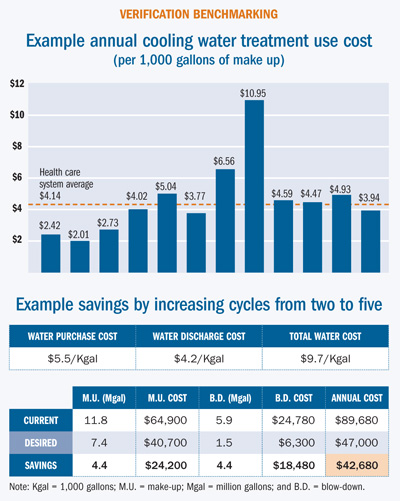 Similarly, it is critical to define water quality standards for the recirculating cooling water. Cooling water, by design, will contain significantly higher concentrations of dissolved solids than the make-up water. This is because of the concentrating effect of evaporation and the desire to conserve water. The goal is to increase the concentration of dissolved solids (cycles) to the maximum point possible, without running a risk of scale deposits forming or fouling, particularly on heat transfer surfaces. Facilities professionals should work with their water treatment representatives to determine the optimum cycles for each system.
Similarly, it is critical to define water quality standards for the recirculating cooling water. Cooling water, by design, will contain significantly higher concentrations of dissolved solids than the make-up water. This is because of the concentrating effect of evaporation and the desire to conserve water. The goal is to increase the concentration of dissolved solids (cycles) to the maximum point possible, without running a risk of scale deposits forming or fouling, particularly on heat transfer surfaces. Facilities professionals should work with their water treatment representatives to determine the optimum cycles for each system.
KPIs are critical to benchmarking performance across a portfolio of systems. This does not mean that facilities professionals should ignore other parameters for benchmarking. However, the KPIs should function as the core set of data commonly used across the industry.
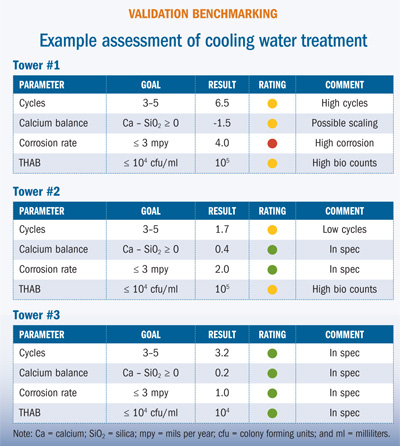 Some of the more common and relatively simple KPIs include cycles of concentration, corrosion rates for mild steel and copper, THAB, calcium and magnesium mineral balance, unscheduled shutdowns or acid washings due to scaling or fouling, softened water hardness and water treatment-use cost.
Some of the more common and relatively simple KPIs include cycles of concentration, corrosion rates for mild steel and copper, THAB, calcium and magnesium mineral balance, unscheduled shutdowns or acid washings due to scaling or fouling, softened water hardness and water treatment-use cost.
More advanced KPIs may include condenser water approach temperature or cost per million British thermal units of heat removed. However, one must be careful not to overly complicate things at the beginning. Getting the basics down first can deliver significant gains.
Test methodology requirements are another important area. For instance, if corrosion rates are going to be monitored, which test methodology will be defined in the performance specification? The organization could establish that a corrosion coupon rack is required on each system installed per Cooling Technology Institute (CTI) Standard 149.
Likewise, does the organization require water quality tests to be run by a certified laboratory or are all tests conducted in the field? It is good practice to include designated testing by certified laboratories to ensure the data are accurate and consistent with field test results.
Next, the organization will want to specify water treatment service requirements. What specific services are required, how often and how will the service work be reported? This is essential for standardizing operating practices and positioning the organization for successful system performance benchmarking.
It is good practice to standardize the service reporting function. Ideally, the service reporting data will be submitted online in a standard format. This approach enables many possibilities, such as alert notifications for out-of-specification conditions, or data mining of past work. In general, facilities professionals should take advantage of online information systems that are specified for this purpose and avoid paper reports that invariably end up in a dusty binder.
Benchmarking strategies
An effective cooling system benchmarking program should include both verification and validation strategies. Verification benchmarks water management implementation practices. Online methods and audits are commonly used to efficiently track whether the required operational practices are being followed. Validation, on the other hand, is a strategy to benchmark water management performance. Validation benchmarking provides third-party evidence that the water management program is performing within specified control ranges for KPIs.
Verification. Verification is defined as evidence that the plan is implemented accurately.
For instance, an organization with a large portfolio of 15 cooling water systems across its facilities may want to free up staff from some routine tasks so they can focus on higher-value activities. So, it installs water meters on its cooling water make-up and blow-down lines. The meters provide pulse–based output signals so water consumption can be monitored automatically. Because the organization already has a system that controls chemical-feed rates and tower conductivity levels automatically, an electronic device can be installed to automatically collect both the water meter and conductivity data, and transmit them to a central database for all systems. Additionally, a cloud-based software application can be used to provide secure login-protected access through the Internet for computers, notebooks and smartphones.
With this basic system, the organization can eliminate daily tower conductivity tests and water meter readings. This improves staff productivity. Additionally, health facilities professionals are now in a position to conduct potentially high-impact but simple benchmarking.
In the software system, the facilities professional manually inputs the number of hospital beds, cost of purchased water, cost of discharged water and annual cooling water treatment expense. By automatically metering water consumption on each make-up and blow-down line, the make-up, blow-down and evaporation water volume can be determined for any defined period. The cycles of concentration also can be determined for each time period.
Armed with these data, a variety of benchmarking opportunities exist. For instance, for a defined cooling season, what is the total volume of cooling water consumed per hospital bed? Or, what is the total cost of cooling water per hospital bed? For some organizations, it may be more useful to evaluate water intensity using building square footage to capture key outpatient care centers.
Facilities professionals also can compute savings potential for evaporation credits and the cost of water treatment per unit volume of water consumed. For instance, what is the annual water treatment cost per thousand gallons of make-up? How does the annual water treatment cost per thousand gallons of make-up compare across the portfolio of cooling water systems? The chart on the facing page provides an example of such an analysis.
Further, how do the tower cycles of concentration compare across the portfolio? Health facilities professionals can use both the water meter data and conductivity data to compute cycles. If some systems are below the optimum level, they can easily calculate the savings opportunity for achieving optimum cycles. The table on Page 34 provides the results of such a calculation.
These types of benchmarking strategies are effective for evaluating water use, cost and treatment metrics.
Validation. Validation provides quantitative evidence about the effectiveness of the program.
Take, for instance, an organization's seeking to implement a simple validation strategy that enables a quarterly snapshot assessment of cooling water treatment. The facilities professional wants highly accurate data and a minimum impact on labor. KPIs established for the assessment are cycles of concentration, calcium balance, THAB and corrosion rates for mild steel and copper.
A credible third-party laboratory is used for cycles, calcium balance and THAB; and the organization's water treatment suppliers produce corrosion rate data using a corrosion coupon rack that is installed following CTI Standard 149.
Cycles of concentration levels should be measured in the laboratory based on silica levels. This is the most accurate measurement technique for cycles due to the high water solubility attribute of silica and the ability to measure its concentration precisely in a laboratory. Calcium balance is measured by comparing silica cycles against calcium cycles. If calcium cycles are lower than silica cycles, this is an indication of scaling.
As demonstrated in the dashboard report illustrated on Page 34, THAB should be benchmarked using the industry standard of less than 104 colony-forming units per milliliter as defined by CTI Legionella Guideline WTB-148. For corrosion, apply a requirement of 3 mils penetration per year (mpy) or less for mild steel, and 1 mpy or less for copper. With established KPI and related metrics, the health facilities professional produces a dashboard report for each system.
Monitoring and validation parameters for the control of viable Legionella bacteria also may be defined.
Many effective strategies
These are some of the many effective strategies for benchmarking cooling water system performance to provide attractive returns on investment and enable new levels of efficiency.
Demonstrating this type of program to administrators will enable facilities professionals to establish a process that is innovative and capable of delivering performance improvements that were previously not possible.
John Tillotson is vice president and principal, and Melissa Cain is regional manager and principal, at Phigenics LLC, Naperville, Ill. They can be reached at jtillotson@phigenics.com and mcain@phigenics.com.
Benchmarking boiler system performance
Many of the best practices for benchmarking cooling water system performance apply to steam boiler systems as well.
Health facilities professionals should start with the big picture and establish goals for economic benefits, environmental benefits and social benefits. They should discuss these goals with the organization's leadership team, again making sure the goals are in alignment with the big picture and leadership has bought into the plan.
Next, facilities professionals should determine whether they have a standard performance specification for steam boiler treatment and management across the organization's portfolio of boiler plants. They will want one specification that covers them all.
The American Society of Mechanical Engineers (ASME) guidelines for water quality in modern industrial boilers contained in "Section VII — Recommended Guidelines for the Care of Power Boilers" of the ASME Boiler and Pressure Vessel Code can be used as a general framework. It is also a good idea to work with a third-party expert to help develop a specification that meets the unique needs of the health care system.
Some of the more common and relatively simple key performance indicators may include cycles of concentration, feedwater iron, make-up water hardness, calcium-to-magnesium mineral balance, unscheduled shutdowns due to scaling or fouling, acid washings due to scaling or fouling, and water treatment-use cost.
Health facilities professionals should follow the recommended benchmarking strategies of validation and verification listed in the accompanying main article.
Validation strategies should provide a quantitative method for confirming that the water treatment and management program is meeting defined specification requirements. For instance, a monthly or quarterly analysis of cycles of concentration may be required, based on silica levels and produced by a certified laboratory. This validation data can be used to compare against assumed cycles of concentration levels based on field tests at the boiler plant. Similarly, the calcium-to-magnesium balance can be analyzed in a lab to determine if the treatment program is preventing scale deposits successfully. Boiler inspections also serve as an important part of a validation strategy to determine if scale is present, how much and so forth.
Similarly, verification strategies for steam boiler systems should follow many of the same principles as the cooling water system strategies. Health facilities professionals should consider benchmarking cost metrics for each facility such as number of hospital beds, cost of purchased water, cost of discharged water, annual steam produced, annual make-up water consumed, annual water discharged, annual fuel expense and annual steam boiler water treatment expense.
From there, health facilities professionals are in position to benchmark steam boiler plants in a variety of ways, including cost of steam per hospital bed, cost for water treatment and other variables.



